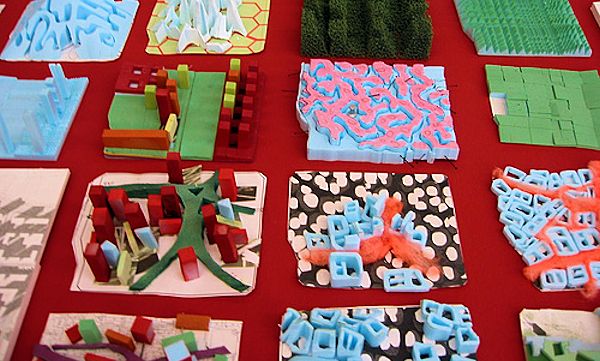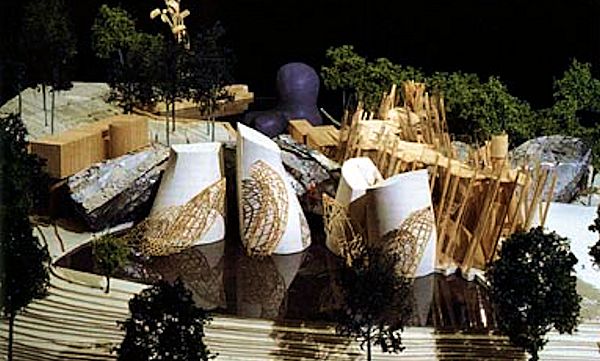2005.08.23 13:28
Tiring architects VS Real Architects
The late period of artists is often under-rated. Picasso's Late Period was mostly disliked while he was alive--seen as repetitious and unimportant. Yet, with Picasso dead, the late works are not so unimportant anymore, in fact they manifest one of Picasso's most creative periods.
Frank Gehry may be in a wonderful position if he continues to do architecture for another decade or so, because, when he isn't around anymore, his late works might just manifest his most creative period.
I like to look at and study the late periods of artists because of all the facile-ness and confidence and even (if you're lucky) the "I don't give a damn" found there.
Philip Johnson produced an interesting late period, and he did change 'styles' with every new project, yet his overall style has always been reenactionary architecturism.
2005.10.12 17:46
Jimmy Venturi's new website...
...like, is it all conscious or sub-conscious, or osmotic even. I like it too because the 'artifacts', the designs, speak for themselves within a much larger architectural continuum.
...and seeing No. 9 again here made me think of the early Gehry three-in-a-row houses in Santa Monica(?), and then a lot of the "glass/wall boxy" houses designed now. And a couple of weeks ago the "pitched roof house" thread and seeing the Vanna Venturi House among the contemporary stuff also brought a perception to my eyes that wasn't there before.
I'll go for the continuum idea as to where architecture is really at.
2007.02.18 18:18
what is today's movement?
Name any current mathematical, scientific or philosophical theory, and there's an architecture that will try to reenact it.
Look at the architecture of Mies, Le Corbusier (especially the late works), and Kahn (especially the early works), and there's a lot of contemporay architecture reenacting all that.
Philip Johnson's architecture is one reenactment after another.
Frank Gehry's architecture evolves via reenacting itself.
You want something original? Just reenact with a twist.
twist
–verb (used with object)
1. to combine, as two or more strands or threads, by winding together; intertwine.
2. to form by or as if by winding strands together: Several fibers were used to twist the rope.
3. to entwine (one thing) with another; interlace (something) with something else; interweave; plait.
4. to wind or coil (something) about something else; encircle; entwine; wreathe.
5. to alter in shape, as by turning the ends in opposite directions, so that parts previously in the same straight line and plane are located in a spiral curve: The sculptor twisted the form into an arabesque. He twisted his body around to look behind him.
6. to turn sharply or wrench out of place; sprain: He twisted his ankle.
7. to pull, tear, or break off by turning forcibly: He twisted the arm off the puppet.
8. to distort (the features) by tensing or contracting the facial muscles; contort: She twisted her face in a wry smile.
9. to distort the meaning or form of; pervert: He twisted my comment about to suit his own purpose.
10. to cause to become mentally or emotionally distorted; warp: The loss of his business twisted his whole outlook on life.
11. to form into a coil, knot, or the like by winding, rolling, etc.: to twist the hair into a knot.
12. to bend tortuously.
13. to cause to move with a rotary motion, as a ball pitched in a curve.
14. to turn (something) from one direction to another, as by rotating or revolving: I twisted my chair to face the window.
15. to combine or associate intimately.
–verb (used without object)
16. to be or become intertwined.
17. to wind or twine about something.
18. to writhe or squirm.
19. to take a spiral form or course; wind, curve, or bend.
20. to turn or rotate, as on an axis; revolve, as about something; spin.
21. to turn so as to face in another direction.
22. to turn, coil, or bend into a spiral shape.
23. to change shape under forcible turning or twisting.
24. to move with a progressive rotary motion, as a ball pitched in a curve. 25. to dance the twist.
–noun
26. a deviation in direction; curve; bend; turn.
27. the action of turning or rotating on an axis; rotary motion; spin.
28. anything formed by or as if by twisting or twining parts together.
29. the act or process of twining strands together, as in thread, yarn, or rope.
30. a twisting awry or askew.
31. distortion or perversion, as of meaning or form.
32. a peculiar attitude or bias; eccentric turn or bent of mind; eccentricity.
33. spiral disposition, arrangement, or form.
34. spiral movement or course.
35. an irregular bend; crook; kink.
36. a sudden, unanticipated change of course, as of events.
37. a treatment, method, idea, version, etc., esp. one differing from that which preceded: The screenwriters gave the old plot a new twist.
38. the changing of the shape of anything by or as by turning the ends in opposite directions.
39. the stress causing this alteration; torque.
40. the resulting state.
41. a twisting or torsional action, force, or stress; torsion.
42. a strong, twisted silk thread, heavier than ordinary sewing silk, for working buttonholes and for other purposes.
43. the direction of twisting in weaving yarn; S twist or Z twist.
44. a loaf or roll of dough twisted and baked.
45. a strip of citrus peel that has been twisted and placed in a drink to add flavor.
46. a kind of tobacco manufactured in the form of a rope or thick cord.
47. a dance performed by couples and characterized by strongly rhythmic turns and twists of the arms, legs, and torso.
48. the degree of spiral formed by the grooves in a rifled firearm or cannon.
49. Gymnastics, Diving. a full rotation of the body about the vertical axis.
50. a wrench.
[note to self: reenactment with a twist, is that what Hejduk's architecture is really all about?]
| |
2007.04.09 18:44
3DH Gallery
The 3-dimensional grid has been an implicit architectural/structural design tool pretty much since architecture began.
Yes, Guggenheim Bilbao came in on budget, but that doesn't erase the fact that is was an extremely expensive building as well.
When it comes to optimal (economical) square foot usage, stricter adherence to the grid still wins out.
Architectural design is not structure alone.
2007
Domestic Museum 2381
2007.09.13
Quondam ideas
Fill in the Philadelphia Museum of Art (blank) plan with excerpts from other museum plans. Do this for three levels above ground, and also do a series of below ground plans (a la the new Gehry project/expansion). This will be the Museum within Ichnographia Quondam (along with Parkway Interpolation and the Bilocating Barnes and Calder Musuem).
2008.05.29 09:27
Can you say canonical?
"...you might like to know that Ten Canonical Buildings: 1950-2000 will be released on June 24, 2008.
Peter Eisenman, renowned for his own controversial and influential body of work, looks at ten leading architects of the twentieth century and their theoretical positions, technological innovations, and design contributions. Eisenman identifies a project within the oeuvre of each of these architects—Luigi Moretti, Ludwig Mies van der Rohe, Le Corbusier, Louis Kahn, Robert Venturi, James Stirling, Aldo Rossi, Rem Koolhaas, Daniel Libeskind, and Frank Gehry—that has profoundly affected architectural discourse and practice. With drawings, diagrams, and always-incisive text, he presents each architect's theoretical position, and then offers detailed critical analysis of the project."
Any guess what the 10 buildings might be? Your own picks?
Moretti: Casa del Girasole (Eisenman)
Mies: Seagrams (Eisenman)
Le Corbusier: Palais des Congrès (me)
Le Corbusier: Olivetti Center Milan (me)
Kahn: Dominican Sisters Convent (me)
Venturi & Rauch: Franklin Court (me)
Stirling: Leicester Engineering (Eisenman, "Real and English")
Stirling: Nordrhein/Westfalen Museum (me)
Stirling: Wallraf-Richartz Museum (me)
Rossi: Modena Cemetery (Eisenman)
Koolhaas: Patent Office (me)
Libeskind: who cares (me)
Gehry: Wagner Residence and other residences of that era (me, just to be a bit obscure)
2008.08.22 21:00
peter's canon
If that's that case, then don't leave out the influence of Gehry on late Eisenman.
| |
2008.08.22 22:05
peter's canon
Just did a side by side chronological overview of the work of Gehry and Eisenman, and in terms of architectonic, geometrical experimentation, Gehry manifests a greater and more mature repertoire.
Eisenman goes through a lot of intellectual and theoretical rigor to ultimately arrive at his geometry, but Gehry simply demonstrates that the intellectual and theoretical rigor isn't even necessary when it come to unprecedented architectonic geometries.
The only reason Eisenman's approach gets respect is because it fits well into 'higher' education. To have students pay large amounts of money to then learn that, "Hey, just look at Gehry, you can design pretty much anyway you want these days." just wouldn't go over well.
2008.08.23 15:16
peter's canon
One thing that crossed my mind last night was how, when I see the many study models of H&dM...

...and OMA...

..I'm reminded of the many study models produced by Gehry for the Lewis Residence...

(I may be stretching it, but...)
Gehry's method of design via innumerable study models seems to have become quite influential.
Personally, I like seeing all the study models of various projects by various architects. I like it because it clearly demonstrates just how pliant architectural designing can be. And I seriously consider the notion that it may well be Gehry that best introduced architectonic pliancy to the profession.
Is architectonic pliancy in somewhat sharp contrast to Eisenman's method? Up to a certain point (in time) I'd say yes. And when Eisenman's work started exhibiting some measure of pliancy, that's where I start to see Gehry's influence.
Have Gehry's designs of late become somewhat predictable and/or seemingly uninspired? Perhaps the pliability metaphor applies here too; perhaps the pliancy has been lost for being stretched too much and too far.
Another thing I like about all the study models is that so often almost any one of the models looks to be an exciting and/or interesting building. And often too it is within the collection of study models that one finds the riskier designs. "Getting it right" isn't the only operation going on. There's also a having-to-let-go of good designs.
To suspect that Eisenman's process conceals a much more pliant process doesn't eliminate Gehry's already self-evident very pliant process. Gehry's entire oeuvre is evidence of a very pliant design process.
Has Eisenman really been designing a process? It looks to me more like he's been designing a determinism, and I am personally aware of an aspect of Eisenman's process that proves very inflexible.
|